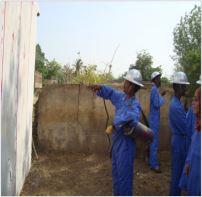 Capacity enhancement of indoor residual spraying applicators from El-Hoosh and Hagabadalla at Sennar Training CentreEpidemiology
Capacity enhancement of indoor residual spraying applicators from El-Hoosh and Hagabadalla at Sennar Training CentreEpidemiology
- In three of the four-study areas malaria transmission is very low, resulting in no additional protection with indoor residual spraying (IRS).
- In Gabalat (highest transmission), there has been a reduction in prevalence in the IRS and long-lasting insecticide nets (LLINs) study group compared to the LLIN only group, following replacement of deltamethrin in 2012 to bendiocarb in 2013.
Entomology
- An. arabiensis is susceptible to bendiocarb, but resistant to deltamethrin in all sentinel clusters
- Allele frequency of knock down resistance (kdr) in An arabiensis was higher in Galabat compared to the other areas, but a relationship between kdr frequency and malaria incidence (or malaria prevalence) was not apparent.
- In the LLIN and IRS arm, the peak Human Biting Rate (HBR) for indoor and/or outdoor occurred between 19:00 and 22:00 hours and ceased between 01:00 and 04:00 hours, while in the LLIN arm, HBR began from 19:00 hours peaking between 01:00 and 04:00 hours.
Cost-effectiveness
- Preliminary results indicate LLIN distribution was less costly than IRS.
- The majority of the expenditure for the LLIN intervention was commodity costs for the LLINs.
- For the IRS intervention the majority of the expenditure was the insecticide and wages of spray personnel.
Conclusions
Results to date show some additional protection in the combination arm, but the evidence for this is weak. Furthermore, there has been no evidence of any relationship between malaria incidence or prevalence and phenotypic resistance in this study. It is therefore, speculation at this stage, whether any additional impact due to IRS is related to pyrethroid resistance.
Related links
Global plan for insecticide resistance management in malaria vectors [pdf 7.2Mb]
WHO policy recommendation on malaria diagnostics in low transmission settings, March 2014
WHO recommendations on the sound management of old long-lasting insecticidal nets, March 2014


